Scotland's Wellbeing: national outcomes for disabled people
Analysis of the National Performance Framework (NPF) outcome indicators from the perspective of disability.
1. Introduction
In May 2019, Scottish Government published a baseline report on performance against the National Performance Framework. This wellbeing report presented an overall picture for Scotland and encouraged decision makers to dig deeper into the evidence, looking across National Outcomes to think about performance and inequality.
This report builds on the wellbeing report, comparing the experiences and outcomes of disabled and non-disabled people in Scotland. It does so by presenting breakdowns of the National Performance Framework indicators by disability status, where relevant[1] and possible. Where such breakdowns are not possible, alternative indicators have been considered. This report focusses on the NPF outcomes at a national level but further work is ongoing looking at different aspects of disability and different areas of service provision. Key developments include:
- ‘A Fairer Scotland for Disabled People’ Action Plan, published in 2016 sets out the Scottish Government's approach to policy for disabled people. Its aim is that disabled people can live the life they choose, participating equally alongside other citizens in their families, communities, workplaces and wider society, with the support they need. This Action Plan commits to 93 actions developed in consultation with disabled people.
- Ongoing work by the Scottish Government to deliver recently devolved disability benefits, in the context of developing a social security system with the principles of fairness, respect and dignity at its core. This process has employed a process of ‘co-design’ which has embedded consultation with lived experience of social security policy throughout.
- A Disability Employment Action Plan (DEAP), published in 2018, designed to address the disability employment gap, alongside long-term targets for economic participation from disabled people.
- The development of an Equality Evidence Strategy and online Equality Evidence Finder to provide access to national statistics broken down according to various demographics including disability status.
The Social Model of Disability
This report adopts the social model of disability, which was developed by disabled people: activists who started the 'Independent Living Movement'. Unlike the medical model, where an individual is understood to be disabled by their impairment, the social model views disability as the relationship between the individual and society. In other words, it sees the barriers created by society, such as negative attitudes towards disabled people, and inaccessible buildings, transport and communication, as the cause of disadvantage and exclusion, rather than the impairment itself. The aim, then, is to remove the barriers that isolate, exclude and so disable the individual. However, as the social model is seldom used in the context of survey-based data collection, statistics using this definition are limited.
The Prevalence of Disability in Scotland
Disability is defined in the Equality Act 2010 as ‘a long-term limiting mental or physical health condition, that has a substantial negative effect on your ability to do normal daily activities that has lasted, or is expected to last, more than 12 months. The key elements of this definition are that there is a long-lasting health condition and that this condition limits daily activity’.
In Scotland, disability is often measured in large-scale surveys using a two-part definition. The first part asks participants if they have a long-term illness or health condition that is expected to last more than 12 months. Second, participants are asked whether this condition limits their day to day activity, either by ‘a lot’ or ‘a little’.
In 2017, the Scottish Health Survey (SHeS) estimated that 45% of adults (and 17% of children) had a long term condition or illness, and that 32% of adults (and 10% of children) had long-term conditions that were also limiting (see Figure 1.1). In this context, 32% of the adult population would be considered ‘disabled’, while 68% would be considered ‘not disabled’.
Figure 1.1 Prevalence of long-term conditions, limiting and non-limiting, among adults (aged 16 and over) and children (aged under 16).
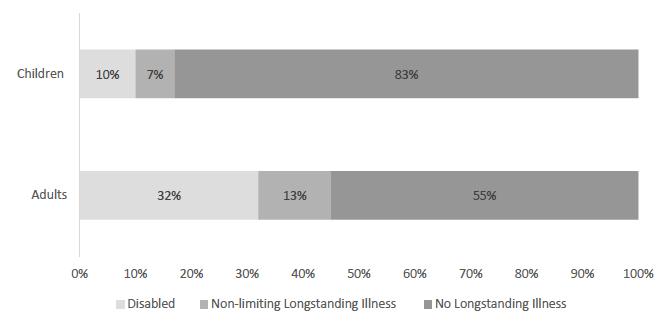
Source: Scottish Health Survey, 2017
In most cases, disability is presented as a single category, without distinguishing between the different barriers that may exist in relation to different conditions. For background, however, the SHeS also provides estimates of the distribution of limiting long-term conditions, which are shown in Figure 1.2 in relation to adults and in Figure 1.3 in relation to children. The results show the percentage of adults with long-term limiting conditions – disabilities – which correspond to the categories. So, for example, Figure 1.2 shows that 15% of those with disabilities have disabilities related to the digestive system, while 41% have conditions relating to the musculoskeletal system. Please note percentages do not sum to 100%, as respondents may have more than one condition.
Figure 1.2 Type of limiting long-term condition – as a percentage of all limiting long-term conditions – among disabled adults.
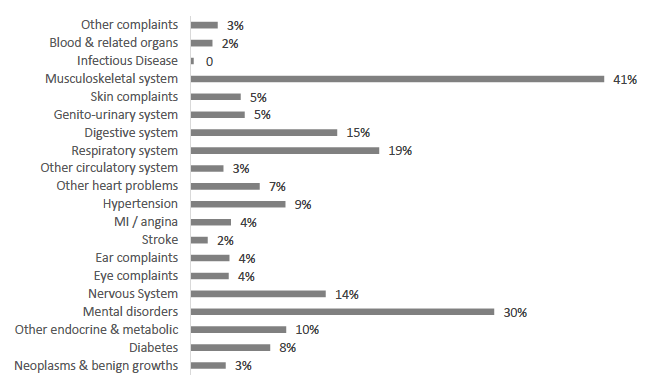
Source: Scottish Health Survey 2017
Figure 1.3 Type of limiting long-term condition – as a percentage of all limiting long-term conditions – among disabled children.
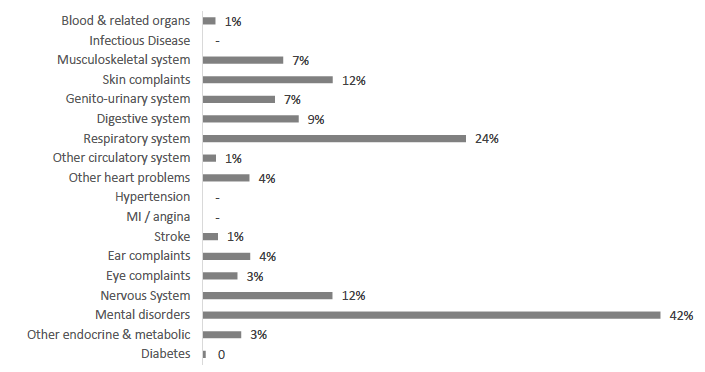
Source: Scottish Health Survey 2017
A note on definitions in this report
Where possible, results in this report refer to survey respondents as either ‘disabled’ or ‘not disabled’. However, in some instances, owing to the form in which the data is presented, three categories are provided, i.e. no long-term illness, a non-limiting long-term illness, and a limiting long-term illness (‘disability’). In other cases, owing to the source of the data that is provided, non-limiting and limiting conditions are not distinguished (such as in the analysis of the Growing Up in Scotland survey in the next chapter). Where necessary, the footnotes alongside the data that is presented clarify the way disability is measured.
Intersectionality: how disability intersects with other characteristics
Disability and Age
The prevalence of disability increases with age. The SHeS estimated that, in 2017, over half of the population have a disability in the over 75 age group (Figure 1.4).
Figure 1.4 Prevalence of limiting long-term health condition by age decile.
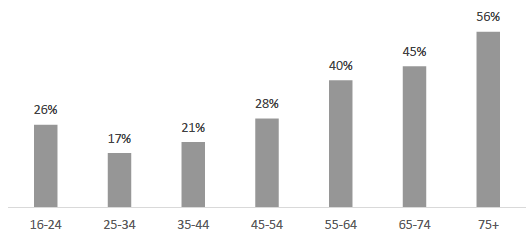
Source: Scottish Health Survey 2017
Disability and Gender
The SHeS also indicates gender disparity in disability rates (see Figure 1.5). In 2017 34% of women reported disabilities, which was higher than the 29% of men who reported these condition. Men were less likely than women to report a disability in various age groups, and the largest gaps can be seen at ages 45-54 (33% to 23%) and 65-74 (49% to 41%).
Figure 1.5 Prevalence of limiting long-term health conditions, by age and gender.
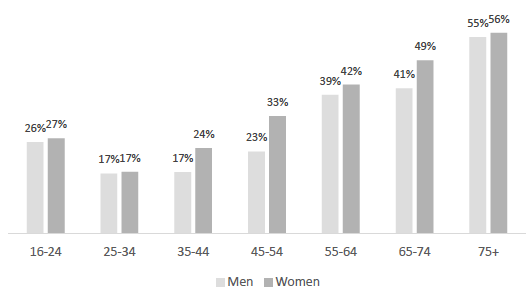
Source: Scottish Health Survey, 2017
Disability and Socio-Economic Status
Disability also varies with socio-economic status. As the SHeS demonstrates, in 2017, 23% of those in the least deprived quintile of the population report disabilities, compared to 43% of those in the most deprived quintile (see Figure 1.6).
Figure 1.6 Prevalence of liming long-term illness among adults, by SIMD quintile.
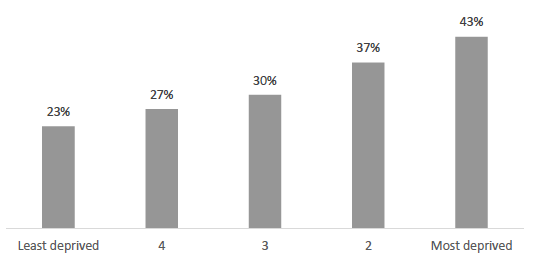
Source: Scottish Health Survey 2017
There also appears to be a relationship between disability and income. The SHeS survey finds that, in 2017, only 22% of those in the top quintile of the income distribution report disabilities, compared to 50% of those in the bottom quintile (see Figure 1.7).
Figure 1.7 Prevalence of limiting long-term illness among adults, by equivalised income.
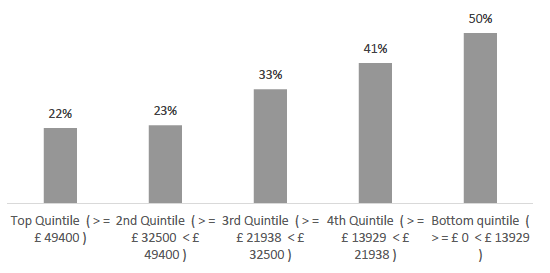
Source: Scottish Health Survey 2017
Disability and Ethnicity
The sample in the SHeS is too small to analyse ethnicity and disability. In the 2011 Scottish Census[2], all other ethnic groups were less likely than the ‘white’ group to report a disability (see Figure 1.8). In this context, ‘white’ refers to white Scottish, white other British and non-British white.
Figure 1.8 Prevalence of limiting long-term illness by ethnicity, 2011.
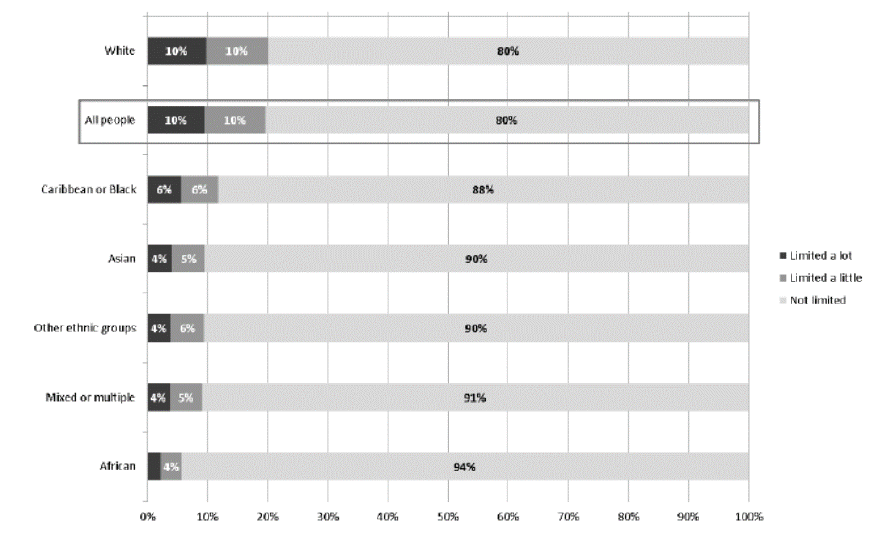
Source: Scottish Census 2011
As above, 90% of those defined in the census as ‘Asian’ and 94% of those defined as ‘African’ did not have such conditions. As the census shows, minority ethnic groups typically have younger age profiles than the population as a whole which, given that prevalence of disability increases with age, may partially explain reduced rates of disability.[3]
Disability and Sexual Orientation
Analysis of the Scottish Core Survey[4] questions found that, in 2017, 29% of those identifying as lesbian, gay, bisexual and ‘other’ reported limiting long-term conditions, compared to 23% of those identifying as heterosexual.[5]
Contact
Email: joseph.ritchie@gov.scot
There is a problem
Thanks for your feedback